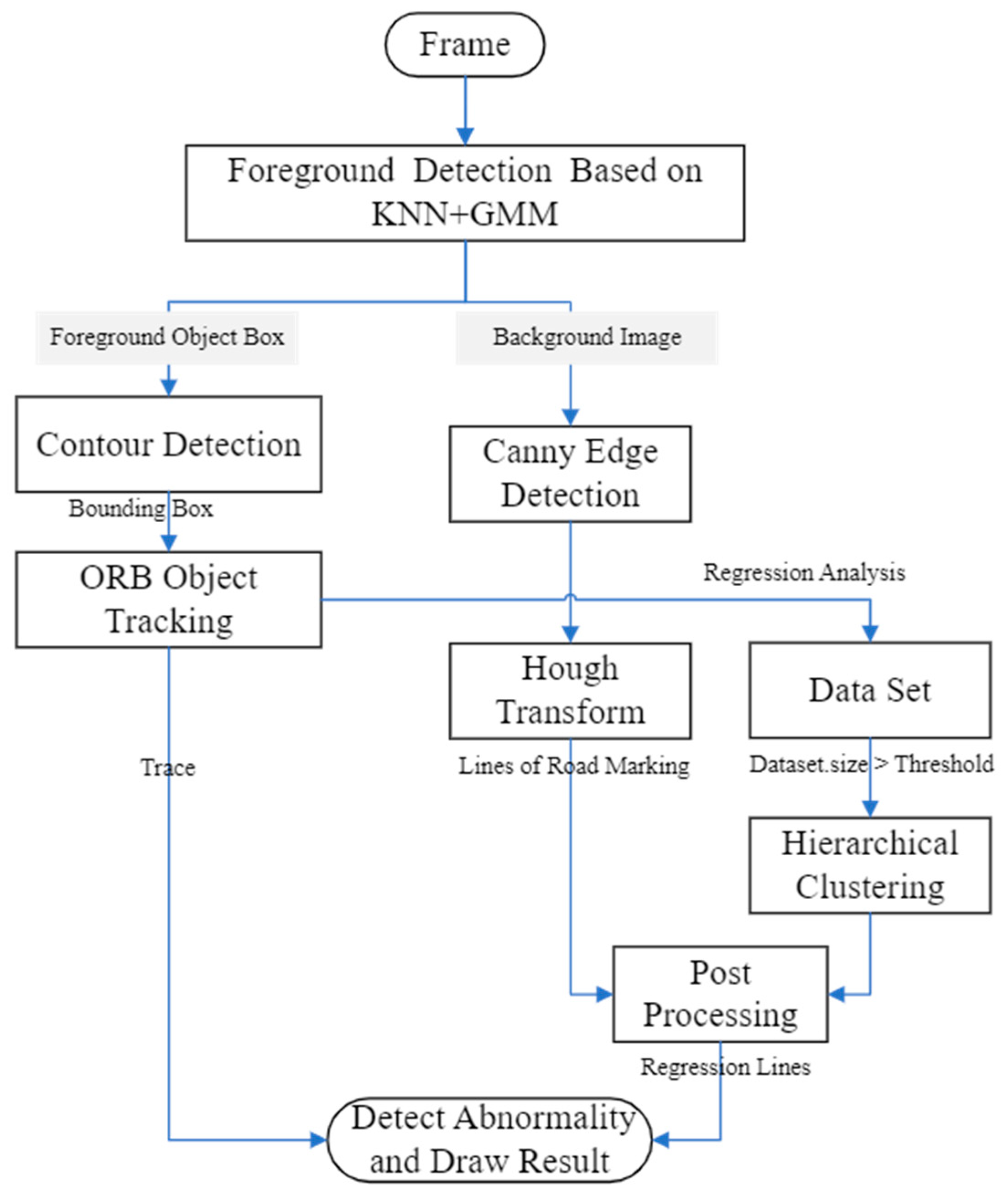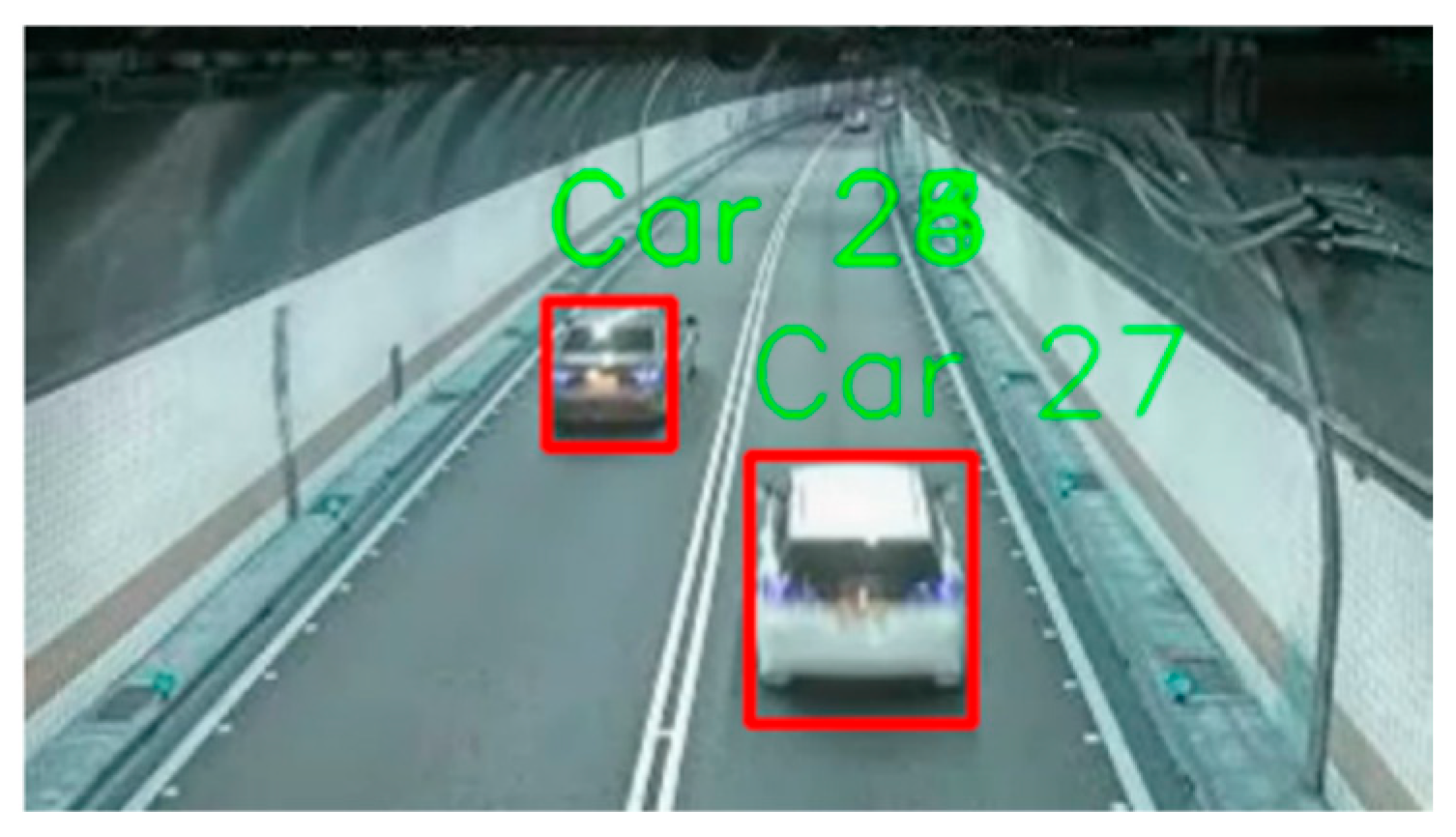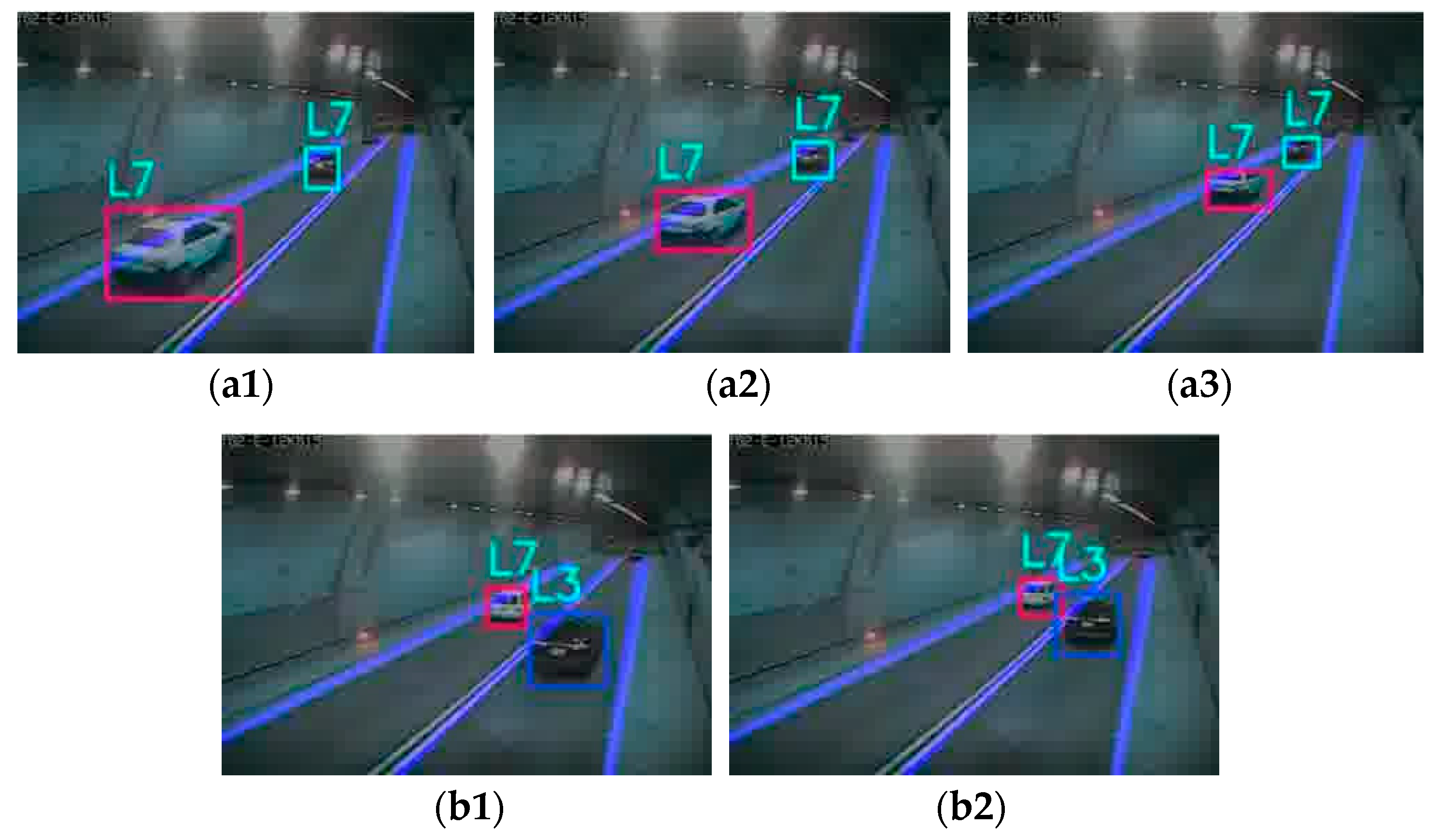Tunnel Traffic Enforcement Using Visual Computing and Field-Programmable Gate Array-Based Vehicle Detection and Tracking †
Abstract
1. Introduction
2. Background Knowledge
2.1. Foreground Detection
2.2. Object Detection
2.3. Object Tracking
- Step 1:
- Obtain frame and the next frame .
- Step 2:
- Predict the next search window based on the current tracked object location box , where , , , and .
- Step 3:
- Detect ORB key points in and , and extract the corresponding binary descriptors and .
- Step 4:
- Match between and , then get two matched subsets of key points and .
- Step 5:
- Calculate the geometric centers of and , denoted as and .
- Step 6:
- Update the location based on the motion vector. If no match is found between and , use the last motion vector .
- Step 7:
- 1 and repeat Step 1.
2.4. FPGA
3. Proposed Architecture and Processing Procedures
3.1. Foreground Detection
3.2. Vehicle Detection
3.3. Vehicle Tracking
3.4. Road Marking Detection
3.5. Training Model
4. Results and Discussions
4.1. Hardware Acceleration
4.2. Performance Test
4.3. Traffic Enforcement
- Vehicle trajectory detection: After detecting vehicles in each frame, vehicle tracking is enabled by analyzing image similarity, distance, and size, assigning a unique ID to each vehicle. The coordinates in each frame are then used for trajectory analysis.
- Lane-switching recognition: By collecting images and filtering out variations, the background view is obtained from the camera’s perspective and analyzes the lane boundaries. With the integration of trajectory analysis, the system identifies lane-switching behaviors, including weaving or driving across lane markings.
- Illegal left and right turn detection: When the camera is positioned at an intersection, the system detects illegal turning behaviors through trajectory analysis and lane recognition.
- Traffic flow statistics: Whenever a new vehicle appears on the screen, it is counted, providing real-time statistics on the number of vehicles entering the camera’s field of view per minute, enabling congestion analysis and monitoring.
5. Conclusions
- Real-time traffic monitoring in tunnels to instantly monitor lane violations and notify law enforcement agencies for subsequent handling.
- Collision prevention in tunnels to immediately alert vehicles behind to reroute and avoid rear-end collisions and traffic congestion in case of an accident.
- Reduced system size and cost by minimizing the system architecture, improving computational speed, and reducing system development costs.
- Automatic adaptation: Since it does not require pre-training, the system automatically adjusts to the local environment and enhances its versatility and ease of use.
- Seamless integration with existing cameras: The system shares and analyzes footage from existing surveillance systems without new installations, reducing deployment costs and increasing coverage of the intelligent monitoring system on the roads.
Author Contributions
Funding
Institutional Review Board Statement
Informed Consent Statement
Data Availability Statement
Conflicts of Interest
References
- Marusin, A.; Danilov, I. A method for assessing the influence of automated traffic enforcement system parameters on traffic safety. Transp. Res. Procedia 2018, 36, 500–506. [Google Scholar] [CrossRef]
- Chen, L.; Zhu, Y. Impact of traffic enforcement technology on urban accident rates: A case study. Int. J. Transp. Technol. 2020, 32, 50–63. [Google Scholar]
- Kumar, P.; Lee, R. Automation in traffic law enforcement: Benefits and challenges. Transp. Res. Rev. 2021, 48, 95–110. [Google Scholar]
- Zivkovic, Z. Improved adaptive Gaussian mixture model for background subtraction. In Proceedings of the 17th International Conference on Pattern Recognition, ICPR 2004, Cambridge, UK, 26–26 August 2004; Volume 2, pp. 28–31. [Google Scholar]
- Kim, J.B. Vehicle detection using deep learning technique in tunnel road environments. Symmetry 2020, 12, 2012. [Google Scholar] [CrossRef]
- Ghanem, S.; Kanungo, P.; Panda, G.; Satapathy, S.C.; Sharma, R. Lane detection under artificial colored light in tunnels and on highways: An IoT-based framework for smart city infrastructure. Complex Intell. Syst. 2023, 9, 3601–3612. [Google Scholar] [CrossRef]
- Sultana, S.; Ahmed, B.; Paul, M.; Islam, M.R.; Ahmad, S. Vision-based robust lane detection and tracking in challenging conditions. IEEE Access 2023, 11, 67938–67955. [Google Scholar] [CrossRef]
- Wu, B.F.; Kao, C.C.; Liu, C.C.; Fan, C.J.; Chen, C.J. The vision-based vehicle detection and incident detection system in Hsueh-Shan tunnel. In Proceedings of the 2008 IEEE International Symposium on Industrial Electronics, Cambridge, UK, 30 June–2 July 2008; pp. 1394–1399. [Google Scholar]
- Liu, W.; Wen, X.; Duan, B.; Yuan, H.; Wang, N. Rear vehicle detection and tracking for lane change assist. In Proceedings of the 2007 IEEE Intelligent Vehicles Symposium, Istanbul, Turkey, 13–15 June 2007; pp. 252–257. [Google Scholar]
- Nguyen, V.Q.; Kim, H.; Jun, S.C.; Boo, K. A study on real-time detection method of lane and vehicle for lane change assistant system using vision system on highway. Eng. Sci. Technol. 2018, 21, 822–833. [Google Scholar] [CrossRef]
- Duda, R.O.; Hart, P.E. Use of the Hough transformation to detect lines and curves in pictures. Commun. ACM 1972, 15, 11–15. [Google Scholar] [CrossRef]
- Suzuki, S.; Keiichi, A. Topological structural analysis of digitized binary images by border following. Comput. Vis. Graph. Image Process. 1985, 30, 32–46. [Google Scholar] [CrossRef]
- Wu, S.; Fan, Y.; Zheng, S.; Yang, H. Object tracking based on ORB and temporal-spacial constraint. In Proceedings of the 2012 IEEE Fifth International Conference on Advanced Computational Intelligence (ICACI), Nanjing, China, 18–20 October 2012; pp. 597–600. [Google Scholar]
- Jadhav, S.; Narvekar, R.; Mandawale, A.; Elgandelwar, S. FPGA based object tracking system. In Proceedings of the 2015 Fifth International Conference on Communication Systems and Network Technologies, Gwalior, India, 4–6 April 2015; pp. 826–829. [Google Scholar]
- Canny, J. A computational approach to edge detection. IEEE Trans. Pattern Anal. Mach. Intell. 1986, 6, 679–698. [Google Scholar] [CrossRef]
- Murtagh, F.; Contreras, P. Algorithms for hierarchical clustering: An overview. WIREs Data Min. Knowl. 2012, 2, 86–97. [Google Scholar] [CrossRef]
- Zhai, J.; Li, B.; Lv, S.; Zhou, Q. FPGA-based vehicle detection and tracking accelerator. Sensors 2023, 23, 2208. [Google Scholar] [CrossRef] [PubMed]
- Redmon, J.; Divvala, S.; Girshick, R.; Farhadi, A. You only look once: Unified, real-time object detection. In Proceedings of the 2016 IEEE Conference on Computer Vision and Pattern Recognition (CVPR), Las Vegas, NV, USA, 27–30 June 2016; pp. 779–788. [Google Scholar]






| Developed Method | YOLO-v2-Tiny with Hardware Acceleration | |
|---|---|---|
| Computing Speed | 480p@20fps | 480p@2fps |
| RAM | <1 MB | ~127 Mb |
| Training Data | 200 frames | ~3 1053 105 pictures |
| Training Time | <10 s | N/A |
Disclaimer/Publisher’s Note: The statements, opinions and data contained in all publications are solely those of the individual author(s) and contributor(s) and not of MDPI and/or the editor(s). MDPI and/or the editor(s) disclaim responsibility for any injury to people or property resulting from any ideas, methods, instructions or products referred to in the content. |
© 2025 by the authors. Licensee MDPI, Basel, Switzerland. This article is an open access article distributed under the terms and conditions of the Creative Commons Attribution (CC BY) license (https://creativecommons.org/licenses/by/4.0/).
Share and Cite
Lin, Y.-C.; Lin, R.-S. Tunnel Traffic Enforcement Using Visual Computing and Field-Programmable Gate Array-Based Vehicle Detection and Tracking. Eng. Proc. 2025, 92, 30. https://doi.org/10.3390/engproc2025092030
Lin Y-C, Lin R-S. Tunnel Traffic Enforcement Using Visual Computing and Field-Programmable Gate Array-Based Vehicle Detection and Tracking. Engineering Proceedings. 2025; 92(1):30. https://doi.org/10.3390/engproc2025092030
Chicago/Turabian StyleLin, Yi-Chen, and Rey-Sern Lin. 2025. "Tunnel Traffic Enforcement Using Visual Computing and Field-Programmable Gate Array-Based Vehicle Detection and Tracking" Engineering Proceedings 92, no. 1: 30. https://doi.org/10.3390/engproc2025092030
APA StyleLin, Y.-C., & Lin, R.-S. (2025). Tunnel Traffic Enforcement Using Visual Computing and Field-Programmable Gate Array-Based Vehicle Detection and Tracking. Engineering Proceedings, 92(1), 30. https://doi.org/10.3390/engproc2025092030





